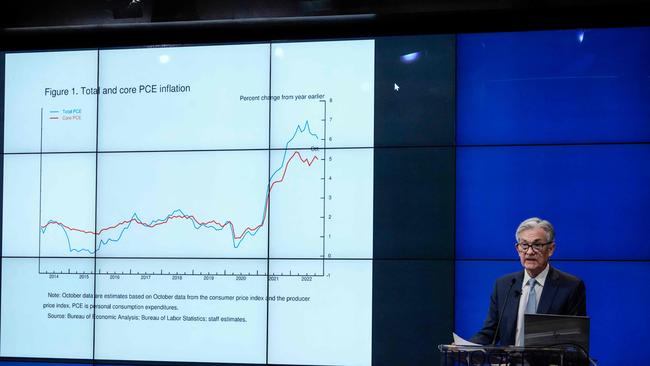Jerome Powell signals Fed prepared to slow rate-rise pace in December
Jerome Powell says a US labour-market slowdown will be needed to bring inflation back to the Federal Reserve’s 2 per cent target.

Federal Reserve chair Jerome Powell indicated the central bank is on track to raise interest rates by a half percentage point at its next meeting, stepping down from an unprecedented series of four 0.75-point rate rises aimed at combating high inflation.
Mr Powell, in a speech Wednesday, said an overheated labour market needed to cool more for the Fed to be confident that inflation would make durable downward progress toward its 2 per cent goal.
Because the Fed has raised rates rapidly and it takes time for those moves to influence the economy, it would make sense for officials to slow rate increases, he said in remarks prepared for delivery at the Brookings Institution. “The time for moderating the pace of rate increases may come as soon as the December meeting,” he said.
Mr Powell reviewed signs of progress on the inflation fight, including a slowdown in interest-rate sensitive sectors of the economy such as housing and improving supply-chain conditions. But he said that declines in goods prices and rents, which have contributed notably to inflation over the last 18 months, might be insufficient if firms don’t slow their hiring.
“The labour market … shows only tentative signs of rebalancing, and wage growth remains well above levels that would be consistent with 2 per cent inflation,” Mr Powell said. “Despite some promising developments, we have a long way to go in restoring price stability.” Inflation is running near a 40-year high and has triggered the most rapid series of interest-rate increases by the Fed since the early 1980s. The Fed seeks to reduce inflation by slowing the economy through tighter financial conditions — such as higher borrowing costs, lower stock prices and a stronger dollar — which typically curb demand.
Fed officials lifted their benchmark rate by 0.75 percentage point on November 2 to a range between 3.75 per cent and 4 per cent. Many officials have signalled they are leaning toward approving a 0.5-point increase at their December 13-14 meeting. They had held the rate near zero until March.
A big question now for the Fed is how much farther to keep raising rates. Some officials are concerned about causing unnecessary damage to the economy and labour market because it takes time for the full effects of those increases to ripple through the economy.
Other policy makers are concerned that price pressures could stay high because, despite improvements in supply chains and commodity markets, prices have picked up for more labour-intensive services.
Mr Powell repeated his earlier view that officials were likely to raise rates to a somewhat higher level early next year than they had anticipated in projections released after their September meeting, when most officials saw their benchmark rate rising to between 4.5 per cent and 5 per cent.
“There is no doubt that we have made substantial progress,” he said. “We have more ground to cover.” Mr Powell’s comments signalled less confidence in forecasts that have repeatedly suggested an imminent and rapid deceleration in price pressures because inflation has mostly “moved stubbornly sideways” over the course of this year.
He focused part of his remarks on exploring why the share of Americans seeking work remains below its prepandemic level. The analysis carries important implications for the setting of interest rates because if wage pressures remain stronger in the coming years, that could lead to a period of greater volatility in wages, inflation and interest rates.
Mr Powell said most of the shortfall appears to reflect older Americans who retired early when the pandemic hit the US in March 2020 — and from slower growth in the working-age population, which he said could reflect reduced levels of legal immigration and a surge in deaths during the pandemic.
Steps to boost workforce participation aren’t controlled by the Fed and wouldn’t be able to take effect rapidly enough to address the current bout of inflation, Mr Powell said.
The upshot is that Fed policy will seek to slow inflation and wage growth by reducing demand for workers, a subject that Mr Powell addressed delicately on Wednesday. “For the near term, a moderation of labour demand growth will be required to restore balance to the labour market,” he said.
While strong wage growth “is a good thing,” he implied it is too high right now to support a return to the 2 per cent inflation rate the Fed targets. “For wage growth to be sustainable, it needs to be consistent with 2 per cent inflation,” he said.
The Wall Street Journal



To join the conversation, please log in. Don't have an account? Register
Join the conversation, you are commenting as Logout